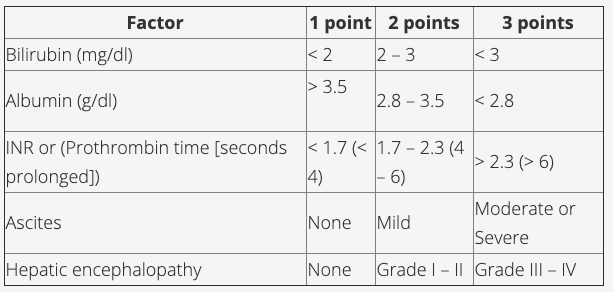Copy link
Child-Pugh score: Factors
Last updated: 03/04/2015
The Child-Pugh score was the first attempt to provide an objective measure of preoperative morbidity and mortality in patients with chronic liver disease. The score measures five favors with each factor scored from 1 – 3. See images below.
Drs. Child and Turcotte of the University of Michigan first proposed this scoring system for liver disease in 1964. It was modified further by Pugh in 1972 to include Prothrombin time (PT). Most clinicians now use the patient’s INR instead of PT. Although the Child-Pugh scoring system was the first of its kind in stratifying the seriousness of end-stage liver disease, it is now used less frequently. The Model for End-Stage Liver Disease (MELD) is used to assess patients for liver transplantation, although both scores seem to be more or less equivalent. The MELD score is perhaps a more accurate assessment of perioperative mortality in patients with hepatic dysfunction. The score is derived from a linear regression model based on serum bilirubin, creatinine levels, and the international normalized ratio (INR).

The Child Pugh Score

This data can be interpreted as above.
References
- R N Pugh, I M Murray-Lyon, J L Dawson, M C Pietroni, R Williams. Transection of the oesophagus for bleeding oesophageal varices. Br J Surg: 1973, 60(8);646-9 PubMed Link
Copyright Information

This work is licensed under a Creative Commons Attribution-NonCommercial-NoDerivatives 4.0 International License.